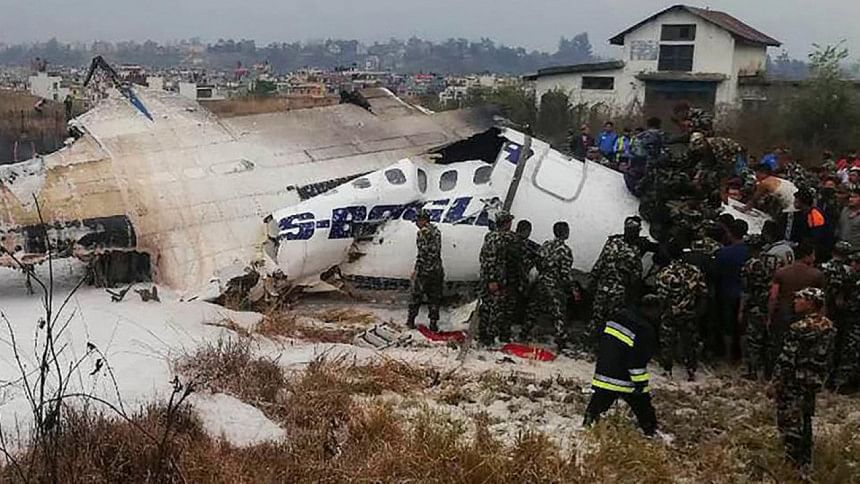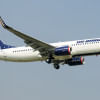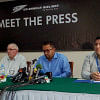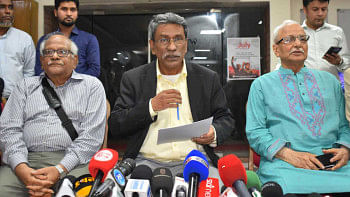Lives lost, answer sought

With the nation reeling from the shock of Monday's tragic plane crash in Kathmandu, two more injured passengers of the ill-fated US-Bangla flight reportedly died yesterday, taking the death toll to 51.
There were 71 people on the 78-seater Bombardier Dash 8, when it slammed on an empty field and burst into flames at the Tribhuvan International Airport.
The Bangladesh Embassy in Nepal yesterday released a list of the casualties mentioning that of the 32 Bangladeshi passengers on board, 22 died in the crash while 10 others were undergoing treatment in hospital.
All the four crew, including pilot Captain Abid Sultan, are also dead, according to Rajkumer Chhetri, general manager of Tribhuvan airport.
The other three are co-pilot Prithula Rashid and flight attendants Khwaza Hossain Mohammad Shafi and Shamim Akter.
Chhetri told this newspaper that the four died on Monday following the crash. He, however, could not confirm whether they passed away on the spot or in hospital.
The Rastriya Samachar Samiti, national news agency of Nepal, quoting the country's home ministry reported that 28 Bangladeshis, 22 Nepalis, a Chinese passenger lost their lives in the accident.
The identities of the two who reportedly died yesterday could not be known.
Also yesterday, the bodies of all the dead passengers were taken to the Maharajgunj-based Tribhuvan University Teaching Hospital in Kathmandu yesterday.
A US-Bangla flight reached Nepal with the family members of the Bangladeshi crash victims from Dhaka. According to the US-Bangla Airlines, 46 members of crash victims' families and seven of its officials boarded the flight.
However, no relatives of Pias Roy, one of the victims, could go as they do not have passports.
The bodies will be handed over to the families following due process and the airline will bear the cost of treatment of the survivors, they said.
Civil Aviation and Tourism Minister AKM Shahjahan Kamal went to Nepal to monitor the situation.
'PEOPLE WERE BURNING
A teacher by profession, Shahreen Ahmed, 29 is undergoing treatment for burn injuries at Kathmandu Medical College Teaching Hospital.
“I was travelling with my friend. When the aircraft was about to land it started turning left. People started shouting. We looked back and saw that the aircraft was on fire. My friend told me to run ahead of him. But while we were running fire engulfed him. He fell down. People were burning, shouting and were falling down. Three people jumped from the burning craft. It was horrific. Fortunately, someone pulled me to safety,” a teary-eyed Shahreen told The Himalayan Times.
Shahreen had planned to visit Kathmandu and Pokhara.
“She has a Lisfranc injury on her right foot. We have put it in a cast. She will undergo surgery after the swelling subsides. She also suffered 18 percent burns on her back,” said Dr Nazir Khan, orthoresident.
Another Bangladeshi citizen, Mehdi Hasan, was travelling by air for the first time. His wife, cousin and her daughter were accompanying him.
"My seat was at the back. When I saw fire I looked for my family. We tried to break open the window, but in vain. We were looking for someone to rescue us. My wife and I were rescued but my cousin and her daughter are missing," he told the Nepali newspaper.
'AIRCRAFT TOTALLY FIT'
Chairman of the Civil Aviation Authority of Bangladesh Air Vice Marshal M Naim Hassan yesterday said the US Bangla dash-8 model aircraft that crashed was “totally fit” to fly before departing Dhaka.
The Caab, however, will check all the aspects of the maintenance and fitness of the aircraft to know whether any loopholes were there, he told reporters at its headquarters.
Naim also said they will go through the personal log book of the pilot, Captain Abid Sultan, to know whether he was engaged in flying extra hours violating the International Civil Aviation Organisation rules.
According to the ICAO rules, he said, a pilot can fly 90 to 100 hours a month. “We will check whether he had crossed the limit.”
Naim said Caab followed all procedures of safety compliance set by the ICAO before departure of any aircraft including the US-Bangla one.
Pointing to successful operation of the same aircraft on Dhaka-Chittagong-Dhaka route on Monday morning before it left for Kathmandu, he said, “That's why its competence is tested. If the aircraft was not fit, it would have failed to fly on Chittagong route.
“Sometimes we go for functional check flight before passengers boarded any aircraft. But in case of this aircraft, it completed operation of two flights in the morning. That's why it is undoubtedly proved that the aircraft was fit enough to operate.”
“All aircraft operating in the country, including those of US-Bangla Airlines, have their airworthiness from Caab. No aircraft can fly in the air without certification or airworthiness of Civil Aviation,” he said.
The Caab chief said the black box of the aircraft will be sent to Bombardier in Canada, the manufacturer of Dash 8, to decode it. "After decoding the black box, we can say whether there was a technical glitch or human error behind the crash."
Naim said the three-member team formed by the Caab is now in Kathmandu to assist its Nepali counterpart in investigating the fatal crash of the US-Bangla aircraft.
The Nepal Civil Aviation authority formed a six-member probe body to investigate the accident.
According to the International Civil Aviation Organisation, conducting probe is the responsibility of that country where the incident has taken place, he noted.
"As per the international aviation rules, we can't conduct investigation in Nepal. But our team will be there to lend support to the probe committee of Nepal."
The Caab chairman said they would try to find out the reason of the crash. "We will also take measures so that this kind of accident cannot take place again in future."
About the reported confusion between the pilot and the control tower of Thribhuvan Airport in Kathmandu, Naim said, "I'm neither endorsing nor rejecting the leaked audio as the YouTube post is not verified."
An unverified audio clip, purportedly of the conversation between the pilot and the air traffic controllers at the airport, suggested confusion over landing clearance and on which end of the runway to land.
'ABID DIDN'T RESIGN'
Meanwhile, the US-Bangla authorities denied the report that Captain Abid had resigned from the airline and joined an Ethiopian company because of his dissatisfaction.
Abdullah Al Mamun, managing director of the airline, said the pilot was assigned to operate the Kathmandu flight following the regulations of ICAO.
Visiting Abid's Uttara residence yesterday, this correspondent witnessed an armed security guard at the gate who was deployed by the airline. The security man didn't allow any reporter inside the building.
However, this correspondent could enter when Mamun walked inside the house around 2:30pm.
Abid's wife Afsana Khanam Tofy said, "I don't know whether he [Abid] resigned or not."
Mamun was heard advising her to stay at her relative's house to avoid media.
'PILOT WAS NOT AT FAULT'
US-Bangla Airlines claimed the pilot wasn't at fault in the plane crash.
"We did not find any problem from the captain's end,” Kamrul Islam, general manager (PR) of US-Bangla Airlines, told reporters at a briefing at its corporate office in Baridhara yesterday.
"He logged over 5,000 flight hours while he has flown the Dash 8 aircraft for 1,700 hours. He had an experience of over a hundred landings in the Kathmandu airport. He was quite familiar with the airfield and the aircraft. We do not think, the captain had any fault,” Kamrul said.
The US-Bangla official said, "We heard the YouTube audio and there is definitely confusion… We have said that it's possible to be misguided from the ATC in such cases. It will take a bit time to recover the data from the black box."

 For all latest news, follow The Daily Star's Google News channel.
For all latest news, follow The Daily Star's Google News channel. 








Comments